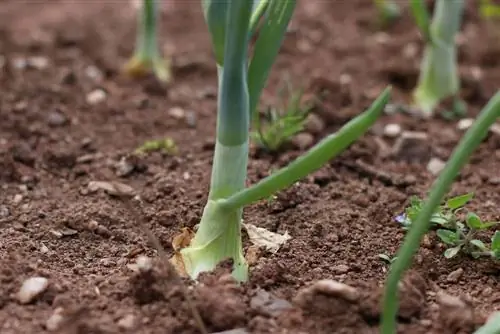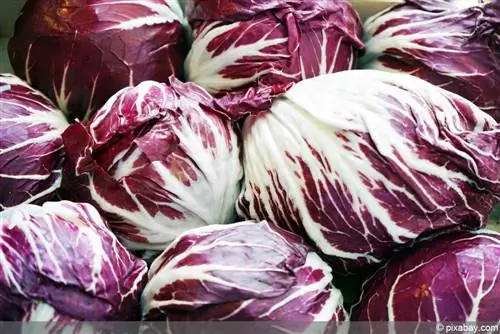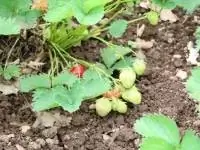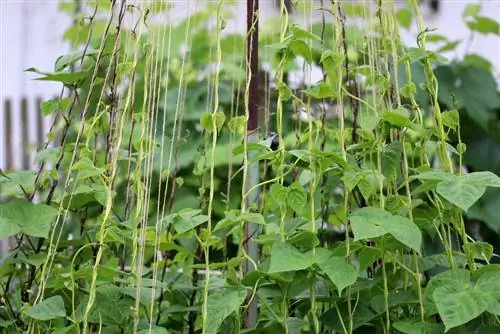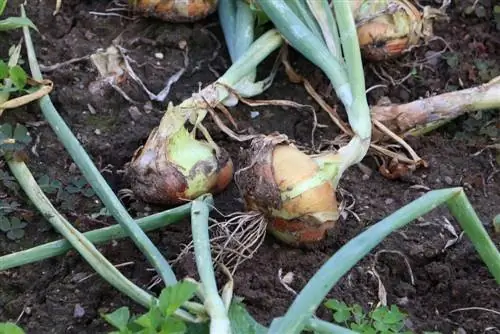- Author admin [email protected].
- Public 2023-12-17 03:39.
- Last modified 2025-06-01 06:48.
More and more people are planting their own onions in the garden these days. For beginners, this may all sound a little complicated. It's not difficult though. Practice makes perfect and the great feeling of success comes with the harvest at the latest.
The right time to sow
Generally, vegetable onion seeds are sown fairly early. Since they germinate despite the cold, this can happen at the beginning of the year. The sowing should even take place by March at the latest. To do this, the gardener spreads the seeds thinly in a row and covers them with soil. After that, patience is required. The first cuttings only become noticeable after about two months. The individual cuttings require around 20 cm of space between the rows and should be moved if they are too close together. It's quicker to use onion sets directly from the garden store. These are planted in spring and can grow slowly.
Care and watering
Onion cultivation should be planned in advance. Even if the seeds are only sown in March, the soil can be prepared in autumn. This means that the weeds are removed and the soil is loosened. It is recommended to mix some compost into the soil. Important: If the soil is acidic, be sure to improve it with lime. This neutralizes the soil condition. If you don't know how acidic your soil is, you should get so-called test strips from a garden store that provide information about the condition. Onions are relatively easy to care for. You can plant them in partial shade as well as in the sun. The only important thing is that they are watered regularly. However, waterlogging should be avoided. Vegetable onions do not tolerate weeds at all, which is why they should be removed between the rows of beds. To ensure that the onions thrive even better, the soil is continually loosened up. Apart from removing weeds and watering, onions do not require any special care. Fertilizer should be avoided because it causes vegetable onions to rot more quickly.
Keep pests away
Pests are found in the best gardens. Unfortunately, these cannot be avoided. But a good gardener knows the best way to get rid of them. A fairly big danger is the onion fly. To protect the plants from this, we recommend a special onion net, which is stretched over the onion. A natural tip also helps keep the flies away. Simply plant a mixed culture with carrots. The smell of the carrot herb immediately drives away onion flies. Another advantage is that if you plant carrots right next to the vegetable onions, you don't have to deal with carrot flies. These are in turn driven away by the smell of the onions. Beetroot and lettuce also work well in the onion bed. This keeps the pests away and gives the gardener a large selection of different vegetables. Attention: Vegetable onions should not be grown in the same bed as legumes and potatoes. Because they don't get along with each other. Marigolds or marigolds, on the other hand, ensure a beautiful appearance and help against fungal diseases.
Onion harvest time

The optimal harvest time for onions is late summer or autumn. Then when the green herb is already wilting. Since the seasons are now shifting, onions may be more ripe sooner. That's why it's important to monitor them regularly. This usually happens at the end of September. After harvesting, the onions are best stored in a dark, cool cellar. This must not be too moist. If the onion is small, it should be processed and consumed immediately as it cannot be stored for a long time.
Wintering onions properly
The wonderful thing about onions is the fact that they are not really susceptible to frost. So winter doesn't really bother them. Nevertheless, it is important to cover the beds. Spruce branches that are placed directly over the bed are suitable for this. This means that frost-sensitive bulbs are more protected and can withstand the pressure from the snow.
Planting vegetable onions on the balcony
If you don't have a garden, you might want to plant onions directly on your balcony. Now there is a question. Is that actually possible? The answer is yes if the following conditions are true:
- There is enough light on the balcony
- Enough space for large pots
As in real soil, the onion seeds should be 5 cm apart. Another 30 cm between the rows. Therefore, on a small balcony there will probably only be one row. The seed depth is approximately 2 cm. The potted onion also needs a lot of water. If the tips of the leaves turn yellow, the onion needs more water. This is especially the case in summer when it is very hot. Onions can be harvested normally in autumn and should then be stored. If you don't have a lot of space in your apartment, you can store them in the refrigerator if necessary. But they shouldn't stay there for too long.
Planting vegetable onions is really not difficult. If you follow the instructions, you usually can't go wrong. Many people don't know how much they can water. The soil should be moist but not floating in water. The gardener can use this information as a guide. The more sun shines on the plants, the more water the bulbs need, otherwise they will dry out. Tip: Do not water directly in the bright sun, but only in the evening. Otherwise the seedlings will burn and be destroyed.
Sowing onions
- Cultivating onions as direct sowing -
Since onions begin to germinate at very low temperatures, namely 2-3 degrees Celsius, they can be sown outdoors quite early. In our latitudes, this is already possible from the end of February, despite the night frosts that are still occurring. To do this, the seeds should be sown in a very well prepared seedbed and not deeper than 1 centimeter. The finer the soil in this bed, the better the success of the sowing. Later the onions must be pricked at intervals of 30x30 centimeters. Using seeds from the previous year achieves the most productive results.
Stick onion
- Use onion sets -
A very convenient method of cultivating onions. Because the bulbs are of a certain size, they can be inserted into the ground at the correct distances required. Transplanting later is therefore unnecessary. Simply make a small hole in the loosened soil with a wooden stick, or with your index finger, water carefully and selectively, stick the onion and press the soil lightly. This is part of the garden work in the month of April. An onion measures 30×30 centimeters when stuck.
Sowing onions, pricking them out and planting them outdoors
Sow the onion either in the apartment in winter in a small indoor greenhouse and then prick out into small pots, or in the greenhouse, but then also sow and prick out the onion at a later date. Then the tender onion plants can be planted outdoors in April. When growing in pots, you may prefer 6-8 seeds in one pot. Later, an onion should be planted outdoors at 30x30 centimeters. With a distance of 30×30 centimeters, the onion beds are also quite easy to weed later.
But which method is the most profitable, best or easiest way to grow onions yourself? This question is almost a question of conscience in onion cultivation, so the onion grower should decide for himself individually. With all three methods, the onion harvest is in late summer.
Sowing, sticking or planting onions, the commonality later is the gardening of onion cultivation. Onion beds must be regularly cleared of weeds by repeatedly loosening up the soil through thorough hoeing. When direct sowing, we recommend visually demarcating with radishes later in the year. The combination of onions and carrots in one bed protects against pests, parasites and parasites of the other crop. If you want to additionally protect the onion culture from onion flies, you can stretch an onion net over the bed.

